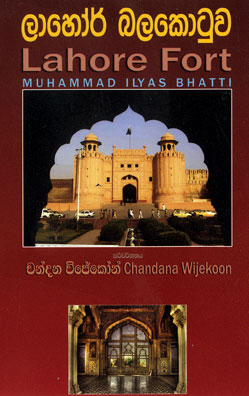A window to Pakistan's rich cultural heritage
Reviewed by Trevor Ludowyke
Lahore Fort - Pakistan's Glorious Heritage, a book written by
Pakistan archaeological specialist Mahammad Ilyas Bhatti, in English,
has been translated into Sinhala by senior journalist Chandana Wijekoon.
The first copy of the book was handed over by the author to Seema Illahi
Baloch, Pakistan High Commissioner in Sri Lanka recently.
The Pakistan High Commission had been greatly supportive and
appreciative of the effort by the author and had in fact facilitated the
author's visit to Pakistan particularly to the iconic Lahore Fort in the
city of Lahore to get a first-hand insight into the magnificent edifice
which stands as one of Pakistan's greatest cultural heritages now
declared as a UNESCO World Heritage site since 1981.
 The Lahore Fort is a testimony to the rule of four Muhgal Emperors
Akbar, Jahangir, Shah Jahan and Aurangzeb between 1526 to 1721. The
author's effort to do justice to a translation of a book written by an
archaeological specialist would not have been an easy task, if not for
the fact that the author was also afforded the opportunity of personally
meeting the original author of the English book Mahammad Ilyas Bhatti
during his visit to the site and discussing the primary focus of the
original book and the historical facts that lay concealed within the
precincts of the magnificent architectural wonder. The author admits in
his introduction that he is not familiar with subjects such as history
and archaeology and hence has translated the material of the original
author for the benefit of the Sinhala readers who would be interested in
the subject. The Lahore Fort is a testimony to the rule of four Muhgal Emperors
Akbar, Jahangir, Shah Jahan and Aurangzeb between 1526 to 1721. The
author's effort to do justice to a translation of a book written by an
archaeological specialist would not have been an easy task, if not for
the fact that the author was also afforded the opportunity of personally
meeting the original author of the English book Mahammad Ilyas Bhatti
during his visit to the site and discussing the primary focus of the
original book and the historical facts that lay concealed within the
precincts of the magnificent architectural wonder. The author admits in
his introduction that he is not familiar with subjects such as history
and archaeology and hence has translated the material of the original
author for the benefit of the Sinhala readers who would be interested in
the subject.
The author is no stranger to journalists or to discerning Sinhala
readers. The translation of the English book makes me realise that
although Chandana is not a historian or an archaeologist, he is a man of
many parts.
As a senior journalist with several decades of experience, Chandana
has earned a reputation among readers as one of a rare breed among the
esteemed members of the fourth estate, while as a writer he has excelled
in communicating with his readers in a simple yet profound manner and
now as an English to Sinhala translator he has done a wonderful job
while also revealing his skills as a good translator and budding
historian and archaeology journalist.
Browsing through the book, the reader's first attraction would be the
colourful front cover page which bears the magnificent facade of the
Lahore Fort with the national flag of Pakistan flying high upon its
rampart flanked by the two watch towers and the open gates of welcome of
the Alamgiri Gate which is the main entrance to the fort.
A grey scale sketch of the ground plan map of the Lahore Fort helps
the reader to locate the various sections of the enormous site, though
at first sight one may not notice the numbering on the map as they are
hardly visible to the passing eye owing to its tiny font size.
After a brief introduction to the site, its history, general plan and
layout, the main features of the fort are described with 46 grey scale
photos in the order that a visitor would follow when entering from the
main entrance during a tour of the fort. It is the author's view that if
the photos of artistic architectural exhibits, paintings and frescos
printed in the book were in full colour, it would have rendered greater
value to the book. It seems that the author has given preference to
making the book available at an affordable price and has therefore been
compelled to sacrifice his desire to use colour photos.
The names and titles of the various sites within the fort seem
somewhat difficult for the reader as they are titles of a foreign
language, but the author has faithfully spelt out the original names of
the sites in Sinhala without translating them so that their historical
value and connotations could be faithfully presented. Each important
site within the fort is explained with historic details of its origin,
usage as well as its relation to other sites within the mega complex and
subsequent reconstruction the multilayered history of one of Pakistan's
main cities to local readers.
The book is a mini-history lesson of an important era of Pakistan;
the Muhgal era and could be useful even to students of world history. It
is a window to Pakistan's rich cultural heritage and historical
developments which also covers the developments around Lahore during the
period of colonial rule. Just as Sigiriya is a World Heritage sites, the
book serves to impress upon readers the rich cultural heritage that is
home to our Asian region. The later part of the book contains a mini
picture gallery of exhibits from the Lahore Museum all of which has a
story behind them and is testimony to Pakistan's Islamic architectural
excellence. Chandana Wijekoon's effort to translate this book into
Sinhala is indeed commendable.
The writer is Senior Cultural Officer, Embassy of Japan.
|


